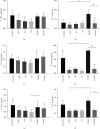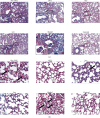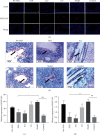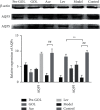Gandan Oral Liquid Improves Exudative Pneumonia by Upregulating Bacteria Clearance via Regulating AQP5 and MUC5AC in Rats
- PMID: 35518345
- PMCID: PMC9064532
- DOI: 10.1155/2022/3890347
Gandan Oral Liquid Improves Exudative Pneumonia by Upregulating Bacteria Clearance via Regulating AQP5 and MUC5AC in Rats
Abstract
Gandan oral liquid (GOL) is a mixture of crude extracts from licorice and Radix isatidis. Clinically, it has been widely used in the treatment of exudative pneumonia (EP) in animals. But the molecular mechanism of these effects is unclear. Therefore, antibacterial activity and therapeutic effect were tested in vitro and in vivo. Exudative pneumonia was established with the intraperitoneal injection of LPS, followed by continuous intranasal inoculation of Klebsiella pneumoniae (KP). After that, Gandan oral liquid, acetylcysteine, and levofloxacin were given through the intragastric route for five days, and clinical symptoms were observed and counted. The bacterial content of alveolar lavage fluid was determined, hematology analysis was performed, and lung histology examination was performed. Western blotting, immunohistochemistry, and immunofluorescence were used to detect the expression levels of AQP3, AQP5, and MUC5AC in lung tissues. ELISA kit was used to detect serum and BALF cytokines levels. The results showed that GOL (242 mg/mL) had no antibacterial activity on Klebsiella pneumonia (KP), and the effect was significantly worse than levofloxacin. However, the therapeutic test in vivo of the rat model of bacterial EP showed different results. After treatment, GOL administration ameliorated EP and increased the expression of mucoprotein -5AC (MUC5AC), and GOL promoted water secretion of the respiratory tract by increasing the expression of aquaporin-5 (AQP5) and decreasing the levels of proinflammatory cytokines (TNF-α, IL-6, and IL-1β). Conclusion. GOL accelerates the water secretion of respiratory tract, inhibits the inflammatory response, induces removal of bacteria of respiratory tract via the AQPs/MUC pathway, and ultimately ameliorates EP.
Copyright © 2022 Yinlong Wang et al.
Conflict of interest statement
The authors declare that there are no conflicts of interest.
Figures







Similar articles
-
[Electroacupuncture improves lung function by suppressing mucin-5AC mediated EGFR-p38MAPK signaling and inflammation reaction in chronic obstructive pulmonary disease rats].Zhen Ci Yan Jiu. 2021 Mar 25;46(3):180-6. doi: 10.13702/j.1000-0607.200420. Zhen Ci Yan Jiu. 2021. PMID: 33798289 Chinese.
-
[Effect of aminophylline and simvastatin on airway inflammation and mucus hypersecretion in rats with chronic obstructive pulmonary disease].Zhong Nan Da Xue Xue Bao Yi Xue Ban. 2016 Jan;41(1):37-43. doi: 10.11817/j.issn.1672-7347.2016.01.006. Zhong Nan Da Xue Xue Bao Yi Xue Ban. 2016. PMID: 26819423 Chinese.
-
Lipoxin A4 ameliorates alveolar fluid clearance disturbance in lipopolysaccharide-induced lung injury via aquaporin 5 and MAPK signaling pathway.J Thorac Dis. 2019 Aug;11(8):3599-3608. doi: 10.21037/jtd.2019.08.86. J Thorac Dis. 2019. PMID: 31559067 Free PMC article.
-
Srolo Bzhtang, a traditional Tibetan medicine formula, inhibits cigarette smoke induced airway inflammation and muc5ac hypersecretion via suppressing IL-13/STAT6 signaling pathway in rats.J Ethnopharmacol. 2019 May 10;235:424-434. doi: 10.1016/j.jep.2019.02.006. Epub 2019 Feb 5. J Ethnopharmacol. 2019. PMID: 30731182
-
Lung edema clearance: 20 years of progress: invited review: role of aquaporin water channels in fluid transport in lung and airways.J Appl Physiol (1985). 2002 Dec;93(6):2199-206. doi: 10.1152/japplphysiol.01171.2001. J Appl Physiol (1985). 2002. PMID: 12433939 Review.
Cited by
-
Therapeutic potential of Lianhua Qingke in airway mucus hypersecretion of acute exacerbation of chronic obstructive pulmonary disease.Chin Med. 2023 Nov 3;18(1):145. doi: 10.1186/s13020-023-00851-4. Chin Med. 2023. PMID: 37924136 Free PMC article.
-
Important functions and molecular mechanisms of aquaporins family on respiratory diseases: potential translational values.J Cancer. 2024 Oct 7;15(18):6073-6085. doi: 10.7150/jca.98829. eCollection 2024. J Cancer. 2024. PMID: 39440058 Free PMC article. Review.
-
Sesamin Induces the Transdifferentiation of Type II Alveolar Epithelial Cells via AnnexinA1 and TRPV1.Lung. 2023 Feb;201(1):65-77. doi: 10.1007/s00408-023-00598-7. Epub 2023 Feb 3. Lung. 2023. PMID: 36735045
-
Animal models of Klebsiella pneumoniae mucosal infections.Front Microbiol. 2024 Mar 15;15:1367422. doi: 10.3389/fmicb.2024.1367422. eCollection 2024. Front Microbiol. 2024. PMID: 38559342 Free PMC article. Review.
-
Impact of N-Acetylcysteine on Mucus Hypersecretion in the Airways: A Systematic Review.Int J Chron Obstruct Pulmon Dis. 2024 Oct 29;19:2347-2360. doi: 10.2147/COPD.S474512. eCollection 2024. Int J Chron Obstruct Pulmon Dis. 2024. PMID: 39493366 Free PMC article.
References
LinkOut - more resources
Full Text Sources

